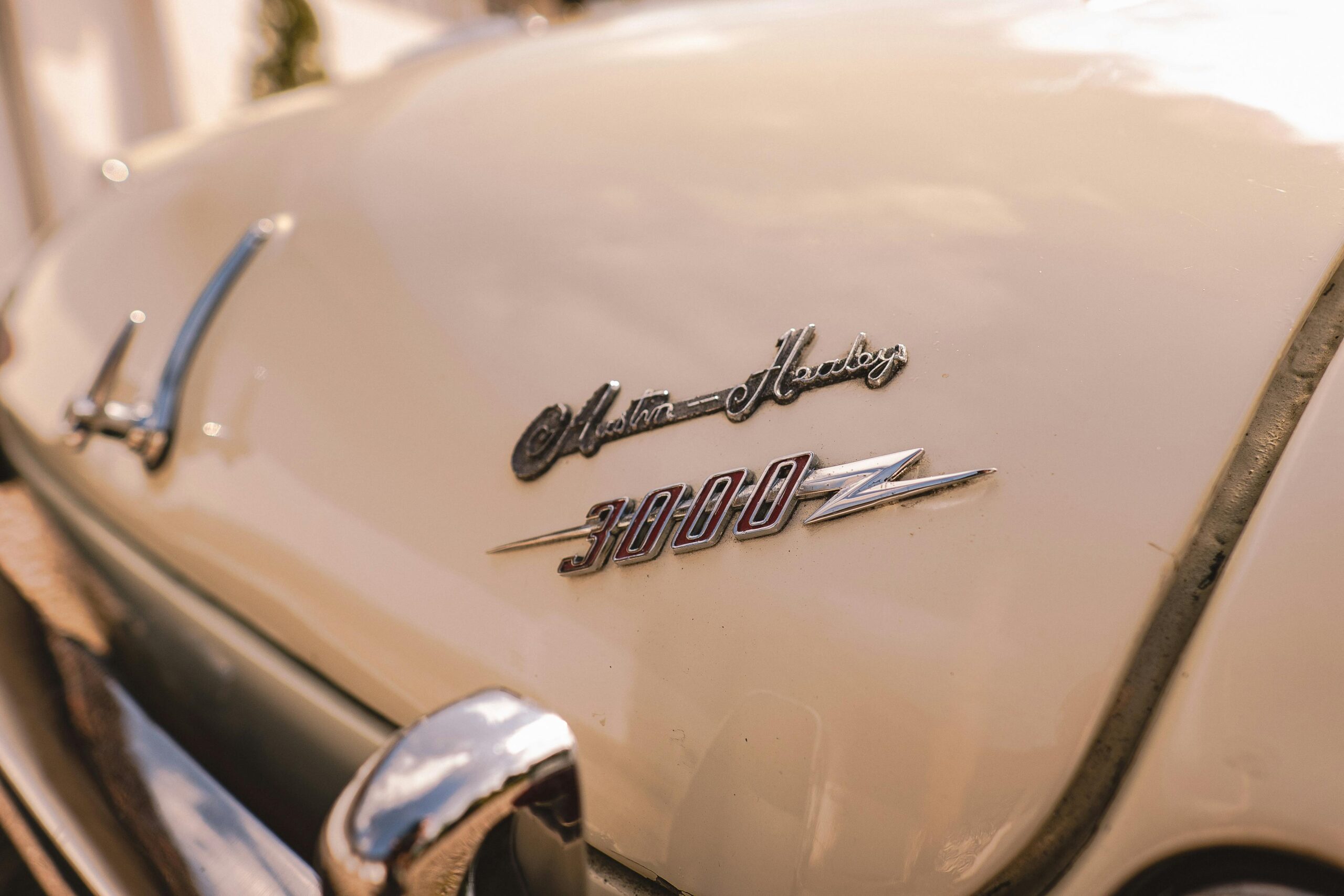The Austin-Healey 3000 sports car remains one of the most iconic and beloved classic cars in automotive history. But why does this vintage British beauty still captivate fans decades after its production ended? In this article, we’ll dive deep into the timeless appeal of the Austin-Healey 3000, exploring what makes it a standout among classic sports cars and why collectors and enthusiasts continue to cherish it. Whether you’re a seasoned car lover or just curious about classic motors, the story behind this legendary vehicle is sure to fascinate you.
The Austin-Healey 3000 classic car is renowned for its perfect blend of style, performance, and heritage. Produced between 1959 and 1967, this British roadster quickly earned a reputation for thrilling drives and elegant design. It’s no surprise that phrases like “classic British sports car” and “vintage Austin-Healey” frequently appear in searches, reflecting ongoing interest from collectors worldwide. What truly sets the Austin-Healey 3000 apart is not just its powerful straight-six engine or sleek bodywork, but the passionate community it has inspired. From vintage car rallies to restoration projects, fans keep the spirit of this classic alive with unmatched dedication.
So, what makes the Austin-Healey 3000 sports car a timeless masterpiece? Is it the unmistakable roar of its engine, the charm of its handcrafted details, or the nostalgia for a bygone era of motoring? Stay with us as we uncover the secrets behind the enduring legacy of this extraordinary classic car, and why it continues to be a dream for collectors and classic car enthusiasts alike. If you’re searching for the ultimate classic British sports car experience, the Austin-Healey 3000 is undoubtedly a name you can’t ignore.
Discover the Timeless Appeal of the Austin-Healey 3000 Sports Car: What Makes It a Classic Icon?
The Austin-Healey 3000 sports car is one of those rare beasts that seem to have captured the spirit of a whole generation, and yet still remain relevant in the car enthusiast world today. It’s not just a vehicle; it’s a symbol of an era when motoring was about passion, style, and performance all blended into one. But what exactly makes the Austin-Healey 3000 stand out so much? Why this classic still captivates fans across the globe, including those in New York, where vintage car culture thrives? Let’s dive in and discover the timeless appeal of this British icon.
The Birth of a Legend: Historical Context
The Austin-Healey 3000 was produced between 1959 and 1967, by the British Motor Corporation in collaboration with Donald Healey Motor Company. It was the successor to the earlier Austin-Healey 100 series, and it quickly made a name for itself in the sports car world. The “3000” part of the name refers to its 3.0-litre engine, which was quite powerful for its time.
In the 1960s, the world was changing fast, with a new generation seeking freedom and excitement. The Austin-Healey 3000 fit perfectly into this cultural shift. It was affordable enough for enthusiasts yet offered the kind of performance and style that typically belonged to much more expensive cars. Even today, its classic British roadster design attracts collectors and drivers alike.
What Makes the Austin-Healey 3000 Sports Car a Classic Icon?
If you ever saw one in person, you might notice the unique design instantly. The long bonnet, low stance, and sleek curves are unmistakable. But beyond looks, several factors contribute to its enduring popularity:
- Engine and Performance: The car came with a 2912 cc inline-six engine capable of producing around 124 to 150 horsepower depending on the model. For a car weighing just over 1100 kg, this meant impressive acceleration and speed for the era.
- Driving Experience: It was praised for its sporty handling and responsive steering. Enthusiasts often mention the thrill of driving a manual gearbox Austin-Healey 3000, something that feels increasingly rare in today’s automatic-dominated market.
- Racing Pedigree: The Austin-Healey 3000 wasn’t just a pretty face; it competed in many prestigious races including the 24 Hours of Le Mans and the Rallye Monte Carlo. Its success on the track only added to its mystique.
- Timeless Design: The car’s aesthetic hasn’t aged badly. It has classic lines that still look fresh nearly six decades after its debut.
- Cultural Impact: Featured in films and media, the 3000 became an icon of cool, often associated with glamor and adventure.
Comparing the Austin-Healey 3000 to Other Classic Sports Cars
To understand why the Austin-Healey 3000 still captivates, it might help to compare it with some contemporaries:
| Car Model | Engine Size | Horsepower | Notable Features | Price Range (Classic Market) |
|---|---|---|---|---|
| Austin-Healey 3000 | 2.9L Inline-6 | 124-150 hp | Lightweight, British styling, racing success | £40,000 – £70,000 |
| Jaguar E-Type | 3.8L Inline-6 | 265 hp | Iconic design, high performance | £70,000 – £150,000 |
| MG MGA | 1.5L to 1.6L Inline-4 | 68-108 hp | Affordable, simple mechanics | £20,000 – £35,000 |
| Triumph TR4 | 2.1L Inline-4 | 105 hp | Robust build, sporty handling | £25,000 – £40,000 |
This table shows the Austin-Healey 3000 offers a balance between performance and price that makes it particularly attractive to collectors who want something sporty but not insanely rare or expensive. Unlike the Jaguar E-Type, the Healey is more accessible, yet it doesn’t compromise on charm or driving excitement.
Practical Reasons Why Fans Still Love the Austin-Healey 3000
- Community and Clubs: There is a strong international network of Austin-Healey clubs offering support, events, and parts. This community makes ownership much easier and more rewarding.
- Restoration Potential: While parts can be tricky to find, many specialists in the UK and US provide restoration services, keeping the cars roadworthy and authentic.
- Investment Value: Classic car enthusiasts often see the 3000 as a good investment due to its steady appreciation over the years.
- Versatility: It’s
7 Powerful Reasons Why the Austin-Healey 3000 Remains a Favourite Among British Sports Car Enthusiasts
The Austin-Healey 3000 is a classic British sports car that has won many hearts since its debut in the late 1950s. Even today, in a world filled with modern, sleek vehicles, this vintage beauty somehow manages to captivate fans and collectors alike. But what makes this particular model so special that it remains a favourite among British sports car enthusiasts? Let’s explore 7 powerful reasons why the Austin-Healey 3000’s charm hasn’t faded, and why it still holds a unique spot in automotive history.
A Rich History and British Heritage
The Austin-Healey 3000 was produced between 1959 and 1967, during a time when British sports car manufacturing was at its peak. It was created from a collaboration between the Austin division of the British Motor Corporation and the legendary Donald Healey Motor Company. This union brought together engineering expertise and sporty design, resulting in a car that wasn’t just fast but also had a distinct British character.
Many enthusiasts love the Austin-Healey 3000 because it represents a golden era of British motoring. It’s not just a car; it’s a symbol of post-war optimism, craftsmanship, and the British passion for motorsport. Unlike newer cars, it carries a story and a soul that modern vehicles often lack.
Impressive Performance for Its Time
Despite its vintage status, the Austin-Healey 3000 was quite a performer back in its day. It was powered by a robust 3.0-litre straight-six engine that delivered around 150 horsepower, which was more than enough to thrill drivers on winding British roads. The car could accelerate from 0 to 60 mph in about 8 seconds, a respectable figure during the 1960s.
Some key performance points include:
- 148-150 horsepower from a 2912cc engine
- Top speed of approximately 120 mph
- Four-speed manual gearbox with optional overdrive
- Rear-wheel drive providing classic sports car handling
These specs made it a favourite among racers and rally drivers, further boosting its reputation as a true sports car.
Timeless Design That Turns Heads
One cannot ignore the Austin-Healey 3000’s design when discussing its popularity. The body features sweeping curves, a long bonnet, and a relatively compact cabin, giving it a sleek and aggressive stance. It’s a car that looks equally at home cruising the English countryside or parading in a classic car show in New York.
What stands out about the design:
- Classic wire-spoke wheels that add vintage charm
- Chrome bumpers and trim that shine in sunlight
- Two-seater configuration emphasizing driver and passenger experience
- Varieties of colours, from British Racing Green to vibrant red, making each model unique
The design remains timeless, never really looking outdated, which is why collectors and drivers still want it.
Strong Community and Enthusiast Culture
One reason the Austin-Healey 3000 remains a favourite is the vibrant community surrounding it. There are numerous clubs, forums, and events dedicated to Austin-Healey owners and fans, both in the UK and internationally. This network provides support for maintenance, restoration, and knowledge sharing, which is crucial for keeping classic cars roadworthy.
For instance, the Austin-Healey Club UK and the Austin-Healey Sports & Touring Club in the USA organise regular meets and rallies. These gatherings help owners connect, swap stories, and showcase their cars, keeping the spirit of the Austin-Healey alive.
Reliability and Ease of Maintenance
Although it’s a classic car, the Austin-Healey 3000 is known for being relatively straightforward to maintain. Compared to other vintage sports cars, it has a simple mechanical layout that allows enthusiasts with moderate skills to service and restore it themselves. Parts, while sometimes expensive, are generally available thanks to the strong community and aftermarket suppliers.
Key maintenance advantages:
- Straight-six engine with well-documented service procedures
- Mechanical components easy to access
- Availability of reproduction parts and manuals
- Strong support from specialist mechanics and clubs
This practicality means the car isn’t just a museum piece; it can still be enjoyed on the road regularly.
Motorsport Legacy and Rally Success
The Austin-Healey 3000 isn’t just a pretty face—it has a notable motorsport pedigree. During the 1960s, this car competed in many international rallies and races, including the famous Monte Carlo Rally. Its robust engine and agile handling helped it achieve respectable finishes against tougher competition.
The racing history adds to the allure for enthusiasts who appreciate performance heritage. Owning an Austin-Healey 3000 is like owning a piece of British motorsport history, which makes it more than just a vehicle—it’s a living legend.
Investment and Classic Car Value
Finally, the Austin-Healey 3000 remains popular because it’s a solid investment. Classic car values have been rising steadily, and this model is no exception. Well-maintained examples can fetch high
How the Austin-Healey 3000 Sports Car Combines Vintage Charm with Modern Collectibility
The Austin-Healey 3000 sports car, a classic British roadster, still holds a special place in the hearts of car enthusiasts and collectors alike. Even decades after its production stopped, this vintage beauty manages to combine the charm of old-school motoring with a modern appeal that keeps its desirability high. Whether you are a seasoned classic car aficionado or a newbie interested in automotive history, the Austin-Healey 3000 offers plenty to admire and explore.
What Makes the Austin-Healey 3000 So Special?
Produced from 1959 until 1967, the Austin-Healey 3000 was the flagship model of the Austin-Healey brand. It was designed to offer both performance and style, targeting buyers who wanted a sporty car without compromising comfort. Unlike many other sports cars of its era, the 3000 featured a robust 3.0-litre inline six-cylinder engine which gave it a distinctive power and sound. This engine was powerful for its time, producing around 150 to 170 horsepower depending on the model variant.
Beyond the engine, the car’s design is also a big part of its appeal:
- Sleek, curvy bodywork with a low stance
- Large chrome grille and round headlights
- Spacious two-seater cockpit with leather seats and wooden dashboard
- Optional hardtop roof for all-weather driving
These design features, combined with its racing pedigree — having competed in events like the 24 Hours of Le Mans and the Monte Carlo Rally — make the Austin-Healey 3000 a remarkable piece of motoring history.
Why This Classic Still Captivates Fans
Even today, the Austin-Healey 3000 is more than just a collector’s item. Many owners still take theirs out for spirited drives, enjoying the raw and unfiltered driving experience that modern cars often lack. The car’s mechanical simplicity means it can be maintained by hobbyists without needing expensive dealer visits. Plus, the sound of the engine and the feeling of the open road evoke a sense of nostalgia that cannot be replicated by newer models.
To understand why it still captivates, consider these factors:
- Timeless aesthetics: The design remains elegant and distinctive, standing out in any classic car gathering.
- Driving experience: Its manual gearbox and responsive handling provide a direct connection between driver and machine.
- Community and culture: There’s an active owners’ club and many vintage car shows where enthusiasts share knowledge and tips.
- Investment value: The rarity and desirability have pushed prices higher over the years, making it a smart collectible.
Comparing the Austin-Healey 3000 to Other Classics
When you put the Austin-Healey 3000 alongside other sports cars from the 1960s, it holds its own quite well. Here’s a simple comparison table showing some key points:
| Feature | Austin-Healey 3000 | Jaguar E-Type | MG MGB |
|---|---|---|---|
| Production Years | 1959 – 1967 | 1961 – 1975 | 1962 – 1980 |
| Engine Size | 3.0 L Inline-6 | 3.8 L Inline-6 (early) | 1.8 L Inline-4 |
| Horsepower | 150 – 170 hp | 265 hp | 95 hp |
| Top Speed | Around 120 mph | Around 150 mph | Around 105 mph |
| Price (Classic Market) | £50,000 – £90,000+ | £70,000 – £150,000+ | £15,000 – £30,000 |
While the Jaguar E-Type is often hailed as the “most beautiful car ever made,” the Austin-Healey 3000 is prized for its raw sporty feel and mechanical honesty. The MG MGB, though more affordable, doesn’t quite match the performance or prestige of the Healey.
Practical Tips for Prospective Owners
If you’re thinking about owning an Austin-Healey 3000, there are few practical things to keep in mind. This car is a vintage vehicle, so its maintenance and upkeep require dedication and some mechanical know-how.
- Regular mechanical checks: Keep an eye on the engine, brakes, and suspension since parts may wear out due to age.
- Rust prevention: The steel bodywork is prone to corrosion, especially in damp climates like the UK or New York winters.
- Parts availability: While many parts are still available through specialist suppliers, some components might be costly or require custom fabrication.
- Insurance and storage: Classic car insurance is a must, and safe storage away from harsh weather helps preserve the car’s condition.
Joining an Austin-Healey club or online forum can also be invaluable for sharing advice and finding
Exploring the Unique Features of the Austin-Healey 3000 That Still Captivate Classic Car Fans Today
Exploring the Unique Features of the Austin-Healey 3000 That Still Captivate Classic Car Fans Today
Few classic cars have the same kind of charm and enduring appeal like the Austin-Healey 3000 sports car. This British icon, first produced in the late 1950s, keeps fascinating enthusiasts and collectors even nowadays, despite being out of production for decades. The reasons behind this car’s lasting popularity are more than just nostalgia – it’s about design, performance, and the distinctive character that the Austin-Healey 3000 delivered, which few vehicles can match. Let’s dive into what makes this classic sports car so special and why it continues to captivate hearts around the world, including here in New York.
The Birth and Legacy of the Austin-Healey 3000
The Austin-Healey 3000 was launched in 1959 by the British Motor Corporation, a collaboration between Austin and the Donald Healey Motor Company. It was the successor to the earlier Austin-Healey 100, but offered significant improvements in power and style. The car was produced until 1967, during which time it saw three main series: Mk I (1959–1961), Mk II (1961–1963), and Mk III (1963–1967). Each had its own tweaks and upgrades, but all shared the same fundamental appeal.
Although the Austin-Healey 3000 was designed as a grand touring car, it was also successfully used in motorsport, especially rally racing. This sporty heritage only added to its allure, making it more than just a pretty face on the road.
What Makes the Austin-Healey 3000 Sports Car So Unique?
Several features set the Austin-Healey 3000 apart from other classic cars, and these elements still resonate with collectors and fans.
Engine and Performance: The car featured a 2.9-litre straight-six engine, which was quite powerful for its time. Depending on the model, the engine produced around 124 to 150 horsepower, allowing the car to reach speeds over 110 mph. While not as fast as some modern sports cars, its performance was impressive during the ’60s.
Distinctive Styling: The Austin-Healey 3000 had a timeless design with a long bonnet, low-slung body, and signature grille. The chrome accents and classic wire-spoke wheels added to its British sports car charisma. It had a two-seater (or 2+2) configuration, with a simple yet elegant interior that emphasized driving pleasure.
Handling and Ride: Known for its balanced handling, the car used independent front suspension and a live rear axle. While the suspension might seem basic today, it gave the car a lively and connected feel on winding roads – something that’s often missing in modern vehicles designed for comfort over thrill.
Convertible Experience: Most Austin-Healey 3000 models came as convertibles, which means drivers could enjoy open-air motoring. This was particularly appealing during summer drives, making it a perfect car for those seeking freedom on the road.
Comparing the Austin-Healey 3000 to Its Contemporaries
When considering classic sports cars of the ’50s and ’60s, the Austin-Healey 3000 often gets compared to models like the Jaguar XK150, Triumph TR4, and MG MGA. Here’s a quick rundown of how it stacks up:
| Feature | Austin-Healey 3000 | Jaguar XK150 | Triumph TR4 | MG MGA |
|---|---|---|---|---|
| Production Years | 1959–1967 | 1957–1961 | 1961–1965 | 1955–1962 |
| Engine Size | 2.9 L straight-six | 3.4 L straight-six | 2.1 L straight-four | 1.6–1.8 L straight-four |
| Horsepower | 124–150 hp | 190–265 hp | 100–104 hp | 68–108 hp |
| 0-60 mph | ~10 seconds | ~8 seconds | ~12 seconds | ~12 seconds |
| Notable For | Classic British styling & rally success | Luxurious & powerful | Affordable & practical | Lightweight & nimble |
While the Jaguar XK150 was more powerful and luxurious, the Austin-Healey 3000 offered a great balance of performance and classic looks with a motorsport pedigree that sets it apart. The Triumph and MG were often more affordable but lacked the same level of engine power or prestige.
Why Classic Car Enthusiasts Still Adore the Austin-Healey 3000
The appeal of the Austin-Healey 3000 goes beyond just numbers and specs. Here are some
Why the Austin-Healey 3000 Sports Car Continues to Dominate British Classic Car Shows in 2024
Why the Austin-Healey 3000 Sports Car Continues to Dominate British Classic Car Shows in 2024
The Austin-Healey 3000 sports car, a name that still rings loud among classic car enthusiasts, seem to be showing no signs of slowing down in 2024. This iconic British vehicle is everywhere at classic car shows across the UK and even abroad, including here in New York. But what is it about this car that keeps it so loved and admired, decades after it first hit the roads in the late 1950s? Well, it’s not just nostalgia or the classic looks; there’s a deeper story about style, performance, and heritage that keeps the Austin-Healey 3000 sports car on top.
A Quick History of the Austin-Healey 3000 Sports Car
Launched in 1959, the Austin-Healey 3000 was produced until 1967. It was the third and final model in the Austin-Healey line, following the 100 and 100-6 models. Built by the British Motor Corporation (BMC), this car was known for its powerful 2.9-litre straight-six engine. Unlike many other British cars at the time, the 3000 was designed with a focus on both speed and style, making it a favourite among sports car lovers.
Some key historical facts:
- Produced between 1959 and 1967
- Powered by a 2912 cc straight-six engine
- Known for its robust performance and classic design
- Popular in rally racing and motorsport events during the 1960s
Why the Austin-Healey 3000 Still Captivates Fans Today
You might wonder, why does a car from over 50 years ago still draw such crowds and admiration? The answer is not simple, but it involves several factors that combine in a unique way.
Timeless Design: The look of the Austin-Healey 3000 is truly timeless. Its long bonnet, sweeping curves, and distinctive grille give it a character that many modern cars lack. It looks sporty yet elegant, and this balance attracts both collectors and casual admirers.
Driving Experience: Unlike many classic cars that feel outdated, the Austin-Healey 3000 offers a driving experience that still thrills. The six-cylinder engine provides a satisfying roar, and the car handles surprisingly well for its age. Owners often say it feels like driving a true sports car, not just a showpiece.
Community and Culture: There is a passionate community of Austin-Healey enthusiasts worldwide. Clubs, meetups, and events dedicated to this model help keep its legacy alive. This social aspect means owners don’t just collect the car; they live the culture around it.
How Does the Austin-Healey 3000 Compare to Other British Classics?
In the realm of British classic cars, the Austin-Healey 3000 competes with models like the Jaguar E-Type, MG B, and Triumph TR6. Here’s a quick comparison to illustrate why the 3000 stands out:
| Feature | Austin-Healey 3000 | Jaguar E-Type | MG B | Triumph TR6 |
|---|---|---|---|---|
| Production Years | 1959–1967 | 1961–1975 | 1962–1980 | 1969–1976 |
| Engine | 2.9L inline-six | 3.8L / 4.2L inline-six | 1.8L inline-four | 2.5L inline-six |
| Top Speed | Around 115 mph | Around 150 mph | Around 105 mph | Around 120 mph |
| Classic Appeal | Strong blend of style & power | Iconic, elegant design | Affordable, easy to maintain | Sporty, muscular looks |
| Motorsport History | Rally success | Racing and road car legend | Club racing | Rally and road racing |
While the Jaguar E-Type might be more famous for its speed and style, the Austin-Healey 3000 offers a unique mix of accessibility and classic sports car charm. It’s often regarded as a more “driver-friendly” classic, which explains its ongoing popularity.
Practical Reasons Owners Love the Austin-Healey 3000
Many classic cars can be a headache to maintain, but the Austin-Healey 3000 has some practical advantages that keep it relevant today:
- Relatively Easy Maintenance: Parts for the 3000 are still available, and many mechanics specialise in it, making repairs easier than some other classics.
- Strong Resale Value: Because of its desirability, well-maintained models hold their value well, sometimes even appreciating.
- Versatility: It’s suitable
Conclusion
In conclusion, the Austin-Healey 3000 remains an iconic symbol of classic British motoring, celebrated for its timeless design, robust performance, and spirited driving experience. Throughout its production years, this sports car captivated enthusiasts with its blend of elegance and power, making it a cherished collector’s item today. Whether admired at vintage car shows or enjoyed on winding country roads, the Austin-Healey 3000 continues to embody the golden era of sports cars. For those passionate about automotive history or looking to own a piece of motoring heritage, exploring the Austin-Healey 3000 is a rewarding endeavour. Its enduring appeal is a testament to British craftsmanship and engineering excellence. If you’re inspired by classic cars, consider delving deeper into the world of Austin-Healey, and perhaps even experience the thrill of driving one yourself—an unforgettable journey into automotive nostalgia awaits.













